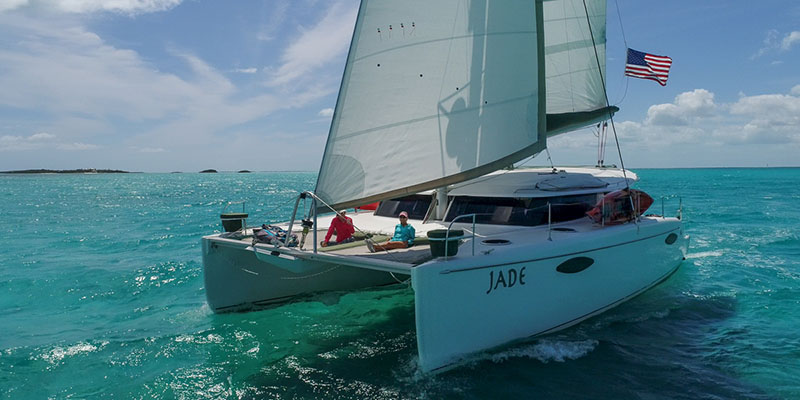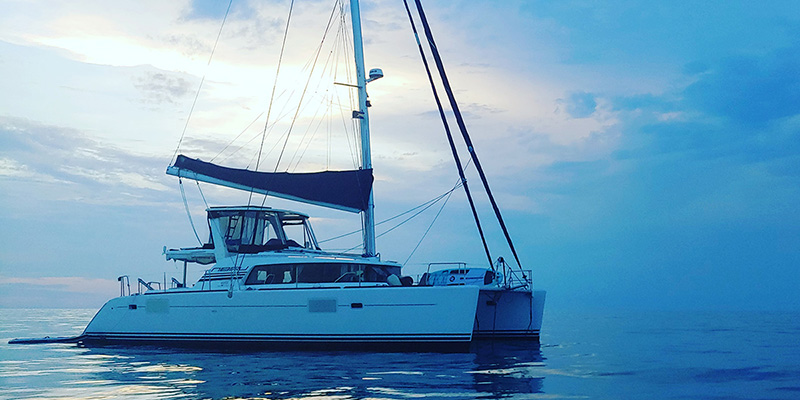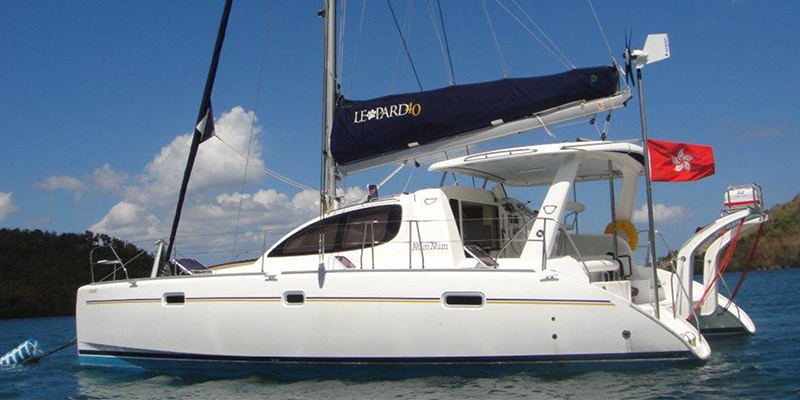Story by Phillip Berman / October 28, 2020

So, you want to get a catamaran, sail off into the sunset, and capture some magic with your lover or family for a few years. You have no ambition to sail around the world or to live aboard forever, but think a one- or two-year sabbatical might be life-changing. You’d like to sail the US East Coast, the Bahamas, the Caribbean, perhaps the Med—or up and down the West Coast and on to Mexico and Central America. You have $300,000 or less to spend and want a catamaran you can sell at the end of the journey without consuming a bottle of Tylenol to blunt the pain.
The good news is that this is quite achievable. The bad news is that there is a vast wave of baby boomers who are all looking for the same thing—and for right around the same price. This makes finding a good deal on a great used catamaran a lot of work, even working with a broker. But, it’s possible. You just need to keep an open mind.
The other good news, which might seem surprising, is that an older catamaran, besides being more affordable, might sail just as well—or even better—than the same-size new cat that will cost considerably more. Yes, the older model might have less room inside and lack the latest condo-on-the-water styling, but it was designed and built before the current trend to supersize the newer generations of multihulls at the expense of sailing performance.
Here’s my advice to the cat hunter on a budget: Don’t get too hung up on the length of the boat. Instead, focus on the spatial and payload requirements you seek and which can be achieved within your budget. And best not get too focused on must-have features—what I jokingly call “surround-sound beds.” Catamaran designs and interiors have gone through massive changes in the past 10 to 20 years, and most older designs simply cannot compete with the new ones in terms of space and high-end amenities.
None of the cool cats I have in mind are over 47 feet. This is not because there aren’t bargain boats out there that are 47 feet and longer, but because any larger multihull that you can buy for $300,000 or less will most assuredly need a significant refit or is either very old or very odd. Buying a fixer-upper is, to my mind, the most dangerous thing a budget-minded consumer can do. It’s just too easy to underestimate the cost of yacht refits and repairs due to the extremely high prices charged in most boatyards.
Nearly any cat you buy over 10 years old is fully depreciated. What we were selling a Lagoon 440 for eight or 10 years ago is nearly the same as what they sell for today. The difference between a good deal and a bad deal is tied solely to a yacht’s condition and refit history. As they joke in private-equity circles, “Any idiot can buy; you deserve congratulations only when you sell.”
So, when your search gets underway, focus on condition—it is far more important than the year, brand or features you might crave. And when you find the cat of your dreams, the best way to remove financial-downside risk is to get a great survey and to choose the newest, smallest cat that will work for your agenda, not the oldest and biggest.
And a word of caution: Your problem will be knowing a good deal from a bad one after the survey is over if you are not well-schooled in pricing. Besides steering you toward potential boats to consider, this is where a broker, working on your behalf, can provide knowledgeable advice. It’s been my experience that this is the point when so many yacht sales come apart: a dispute over the value of a given yacht when the survey results come in. All too commonly we see buyers reject yachts they should have accepted and purchase cats they should have rejected. Remember, a used yacht is a used yacht—not a perfect yacht. A catamaran need not be perfect to remain a perfectly good deal. Here, then, are 10 cool cats to consider in the $300,000-or-less range:

Fountaine Pajot had the misfortune of tooling up this boat just before the global financial crisis, so not that many of them were built between 2007 and 2012. But these were the first of the larger-space charter cats in this size, but not yet so porky that they still could not sail decently. In the three-cabin owner’s version, they designed the living space very nicely; even in the four-cabin version, the aft starboard bed was very well-done.
During this period, Fountaine Pajot had problems with the resin it was using, which led to blistering on the hulls and undersides. Affected models therefore had new bottoms done at approved shipyards throughout the world. Make sure the one you are considering had this done or that it doesn’t show evidence of significant blistering. Honestly it is only cosmetic, but it will impact resale if not repaired. Many consumers think blisters are the end of the world; frankly, they are not.

Built in France by a long-standing yard, the Catana 431 was always a very viable vessel because it is big enough to go anywhere, but not too large for a competent owner to handle. And because the 431 has good underwing clearance and daggerboards, it sails smartly to windward.
That said, there are a few things to watch for. The primary bulkheads on many of these boats were not tabbed on the outer ends, and over time tended to distort. Often this led, or will lead, to a costly replacement of some bulkheads. So be careful to survey these areas properly.
The 431′s furniture is all foam-cored and handmade, but the banding on the outer edges in some cases slowly starts to peel, which allows moisture to infect the wood veneer. This can create a somewhat unsightly appearance in the cabinets and drawers. It is only a cosmetic issue, but it can make the interior feel a bit worn out.
During the period when the 431 was being built, Catana used a distributive electrical card system, and the boats had several modules, each a zone, to which electricity was run. If one thing in a zone stops working, the only solution is to jury-rig a wire from that nonworking item back to the main breaker panel. Replacing the modules or getting them repaired can be done, but it is getting harder by the year. For this reason, the best 431 is a boat that someone else had rewired at some point along the way.

If you need a larger escape pod, the Lagoon 470 is one of our favorites. This model of older Lagoons was built at CNB’s yard in Bordeaux, France, and the build quality was high. The 470 was the first design to have the more-vertical windows that are a Lagoon signature, and ample saloon headroom. The 470s are also old enough that the hulls were not so supersize that it compromised sailing performance. They have decent underwing clearance, so they are not persistent pounders to windward. Many were built with a galley-down layout, some in galley-up style. You will always pay more for an owner version of this or any model.
The big thing you have to concern yourself with on Lagoons of this vintage is that the hulls and decks are made with a balsa core, so it is not uncommon to find moisture problems, especially around deck fittings or hatches. This can sometimes require rebedding or recoring areas, and this sort of repair, in North America, can be a costly undertaking. Make sure you get good moisture-meter readings near all deck fittings and, of course, on the hulls. Hulls, however, tend less often to have moisture issues because there are few fittings through which water can enter the core. Were that to happen below the waterline, it is a real mess that must be repaired immediately and properly.

Back when the Privilège 435 was built, Privilège catamarans were constructed by Alliaura Marine in France, and they were truly the Mercedes of the multihull world at that time. While not a performance cat by any means, the 435 was a super-solid yacht, built with great care and the finest components. The 435 is large enough to go anywhere but small enough to handle easily.
The largest negative of this model—and many cats of this vintage—is that the saloon windows slope dramatically, so the interior gets very hot unless the windows are covered most of the time. When they legalize growing pot on catamarans, here’s the perfect greenhouse for it! Seriously, if you should buy a used 435, you really have to get strong sunblocking external UV covers, as well as interior blinds or shades to inhibit heat buildup.
Some of the 435s were laid out with the galley down in one hull, and these days most people want a galley-up arrangement, where cooking and food preparation are done in the saloon. A three-cabin galley-up owner version will be far more sought after and cost more than a four-cabin galley-down version.

This was the first of the Morrelli & Melvin collaborations with South African builder Robertson and Caine and the charter companies owned at the time by TUI Marine to create a catamaran that could be sold both into charter under the Moorings brand and also privately as a Leopard, so effort was made to design a boat with good sailing performance. Gino Morrelli did a good job creating a lot of underwing clearance, the 46 has a powerful rig, and yet its interior still offers spacious sleeping areas and nice flow from the cockpit to the saloon. These can be bought as ex-Moorings charter boats for less than $300,000 but are more costly in the sought-after Leopard owner version.
Because these are balsa-cored boats, you must inspect deck fittings carefully for moisture incursion. Some of the earlier ones also experienced structural problems on the aft bulkhead and over-door-frame areas between saloon and cockpit. Also, during this period, the windows in the main saloon had a tendency to leak and, when they did, required rebedding or replacement. This was a costly job, so check this out carefully during survey.

If you wish to spend under $250,000, the older Saint Francis 44 and Knysna 440 are worth a look.
Back in 1990, Duncan Lethbridge started St. Francis Catamarans in South Africa with the St. Francis 43. The boat was meant to be a fast, strong bluewater voyager—and it was. The 43 was made with foam core, keeping the structure light, and it was very strongly built, with a powerful rig. The 43 loved to sail. And so too did the St. Francis 44, an updated version of the original.
The boat did have a couple of negatives, however, the first being its sloped windows that built up interior heat. And the boat wasn’t a great fit for tall people, having less than 6-foot-2-inch headroom in the hulls. Also, the engines were installed amidships, which made the boat noisy inside under power. It also made the amidships areas of the hulls too narrow to have centrally located heads and showers, which in turn meant the only layout available was a four-cabin, four-head design. In the forward cabins, the heads and showers had to be far forward; in the aft cabins, the heads and showers were located far aft.
St. Francis sold the tooling for the 44 to Knysna Yachts in 2004, and Knysna raised the headroom in the saloon and moved the engines aft to each stern. The hulls remained fundamentally the same, but the design was improved nicely.
The largest negative of both the Saint Francis 44 and the Knysna 440 is that they have very low underwing clearance. Things can get pretty noisy when pushing against washing-machine seas.
But you cannot have it all and still pay less than $250,000 in a midsize cat; compromises must be made. And these boats do sail quite smartly compared with many in their size range.

This was the most popular catamaran ever made, and it started the catamaran flybridge craze, which helped to convert many powerboaters to sailors.
What I like about the 440 is that it is an infinitely better sailer than some of its peers, and has decent underwing clearance, vertical windows, and nice cabins for sleeping and living. While the aft cockpit is rather small, the saloon is quite large.
Flybridges are a bit of a love-hate thing. There is no question that in a cat of this size, the windward performance suffers a bit due to the boom positioned so high off the water. When piloting, the skipper is separated from those on the bridgedeck. Part of the reason flybridges are so popular in charter is that most of the parties take place up there while sailing and at anchor. In private ownership, however, it is seldom that everyone is hanging out on the flybridge during a long passage.
As always with Lagoons, these are balsa-cored boats, so a careful survey is in order. Pay attention also to bulkhead tabbing to make sure they have not separated from the hulls.
Because so many of the 440s were built to go into charter, there are a lot of four-cabin, four-head models for resale. These will sell for considerably less on the brokerage market than a coveted three-cabin, private-owner model.

When you get into the 40-foot size range, a four-cabin layout can become pretty cramped and claustrophobic below, but the three-cabin owner version of the Leopard 40 is a very nice pocket cruiser. A Morrelli & Melvin design, the 40 has good underwing clearance and nicely shaped hulls. Not a large cat, per se, and less-suited for significant distance sailing than others because its payload is limited, the 40 is still well-suited for a couple and a child or two for near-coastal and island-hopping action.

If you are searching for a cat in the $200,000 range, the Manta 42s were well-built in Florida, and their electrical systems were very well-done compared with many other multihulls of that era. While many of the features on the boat are quite dated, these Mantas sail very well, and easily, and have been popular with coastal cruisers for two decades.
The largest negative of the Mantas is that people taller than 6 feet will find the saloon headroom right on the edge, and the berths are not especially large. Also, forward visibility from the saloon windows is not particularly panoramic, so the interiors are a bit darker inside than current-generation catamarans.

The Lagoon 410 was quite a popular cat in its prime, and for good reason. It offers lots of visibility thanks to its vertical windows, good headroom for a cat of its size, nice berths, and a workable, though smallish, galley-up design. The 410 has decent underwing clearance, can sail nicely over the waves, and its singlehanded operation is super easy. In the three-cabin owner’s configuration, it’s just a very cool little cat.
As always, a balsa-core boat must be surveyed carefully, especially on deck, for moisture incursion near fittings and hatches. It can be costly to repair rotted core and to rebed deck fittings. But find a dry one, and it should definitely be counted as a contender for a buyer with a limited budget.
Phil Berman is the founder of the Multihull Company and the founder of Balance Catamarans. He has managed the sale of more than 900 catamarans.
The process of selling our boat was made very smooth by the Multihull Company and Andrew Hodgdon in particular. Andrew helped us navigate the selling process including moving our boat from Grenada to Florida to execute the sale. We would recommend working with this company, and Andrew Hodgdon in particular, without hesitation.
Very smooth process. Chuck was great and very knowledgeable about the whole process. Im happy to have had TMC to take care of all the things i didnt know about.
Andy
We feel like we got tremendous service from Chuck. He is a total professional, knowledgeable, confident and a natural salesman. While I’m really sad to give up the boat, we are compl we are completely satisfied that Chuck sold it for us.
The Multihull Company-St Augustine, and in particular Andrew Hodgdon handled the sale of my Balance 442 Catamaran. Andrew was professional, transparent and a pleasure to do business with.
Valerie was exceptional. Her experience and the marketplace and contacts and various areas has been most beneficial.
Successful relationships cannot exist without it. At The Multihull Company we base every relationship on a firm commitment to earning and retaining our client’s trust.
Advice of any kind is valuable only when grounded in hard-won expertise. It too, must be trustworthy. Trust and expertise define the heart and soul of The Multihull Company. We are a team of skilled professionals who thrive on providing expert, trustworthy advice and service to catamaran and trimaran sailors around the globe.
Read More